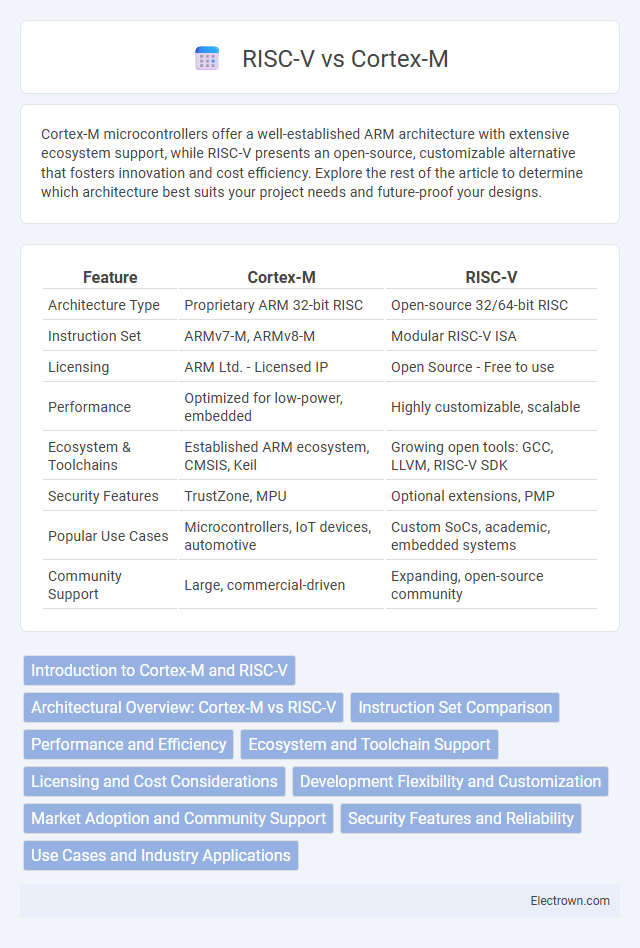Cortex-M microcontrollers offer a well-established ARM architecture with extensive ecosystem support, while RISC-V presents an open-source, customizable alternative that fosters innovation and cost efficiency. Explore the rest of the article to determine which architecture best suits your project needs and future-proof your designs.
Table of Comparison
| Feature | Cortex-M | RISC-V |
|---|---|---|
| Architecture Type | Proprietary ARM 32-bit RISC | Open-source 32/64-bit RISC |
| Instruction Set | ARMv7-M, ARMv8-M | Modular RISC-V ISA |
| Licensing | ARM Ltd. - Licensed IP | Open Source - Free to use |
| Performance | Optimized for low-power, embedded | Highly customizable, scalable |
| Ecosystem & Toolchains | Established ARM ecosystem, CMSIS, Keil | Growing open tools: GCC, LLVM, RISC-V SDK |
| Security Features | TrustZone, MPU | Optional extensions, PMP |
| Popular Use Cases | Microcontrollers, IoT devices, automotive | Custom SoCs, academic, embedded systems |
| Community Support | Large, commercial-driven | Expanding, open-source community |
Introduction to Cortex-M and RISC-V
Cortex-M is a family of 32-bit RISC microcontrollers developed by ARM, widely used in embedded systems for its low power consumption and efficient performance. RISC-V is an open-standard instruction set architecture (ISA) designed for flexibility and scalability, promoting innovation through its open-source nature. Both architectures serve the embedded market but differ fundamentally in licensing, ecosystem, and customization capabilities.
Architectural Overview: Cortex-M vs RISC-V
The ARM Cortex-M architecture features a fixed instruction set optimized for low-power and real-time embedded applications, known for its deterministic interrupt handling and extensive ecosystem support. RISC-V offers a modular, open-source instruction set architecture allowing for customizable extensions tailored to your specific application needs, promoting flexibility and innovation. Cortex-M's proprietary design contrasts with RISC-V's open architecture, making the latter highly attractive for developers seeking adaptable and cost-effective embedded solutions.
Instruction Set Comparison
Cortex-M processors use the ARM Cortex-M instruction set architecture, known for its fixed 32-bit instruction width and efficient Thumb-2 instruction set that optimizes code density and performance. RISC-V offers a modular instruction set with a base integer instruction set and optional extensions, allowing for customizable design and scalable performance across various applications. Your choice between Cortex-M and RISC-V depends on specific application requirements, such as ecosystem support with ARM or flexibility and extensibility with RISC-V.
Performance and Efficiency
Cortex-M processors deliver high-performance computing with energy-efficient ARM architecture optimized for embedded systems, offering predictable real-time capabilities and extensive ecosystem support. RISC-V chips provide scalable performance and customizable efficiency, allowing You to tailor core designs for specific workloads and power constraints with an open-source instruction set. Both architectures balance compute power and energy consumption, but RISC-V's flexibility can lead to better optimization in specialized applications, whereas Cortex-M excels in standardized, low-power environments.
Ecosystem and Toolchain Support
Cortex-M processors benefit from a well-established ecosystem backed by ARM's extensive toolchain support, including widely adopted IDEs like Keil, IAR, and ARM's own DS-5, ensuring comprehensive debugging and optimization capabilities. RISC-V, being open-source, offers growing but less mature toolchains such as GCC, LLVM, and newer IDE integrations, with a dynamic community rapidly expanding libraries and support resources. The Cortex-M's mature ecosystem facilitates robust commercial development, while RISC-V's open architecture encourages innovation and customization, gradually closing the gap in professional toolchain support.
Licensing and Cost Considerations
Cortex-M processors require licensing fees from Arm, impacting your project's budget, especially for commercial applications, while RISC-V offers an open-source ISA with no licensing costs, providing greater flexibility and cost savings. The open nature of RISC-V fosters community-driven innovation and customizable implementations without royalty payments. Choosing RISC-V can significantly reduce initial development expenses and long-term licensing commitments compared to the proprietary Cortex-M architecture.
Development Flexibility and Customization
RISC-V offers superior development flexibility and customization due to its open-source architecture, enabling developers to tailor instruction sets and integrate custom extensions without licensing restrictions. In contrast, Cortex-M cores by Arm provide a fixed, proprietary instruction set with standardized features, limiting customization but ensuring robust ecosystem support and compatibility. Developers seeking maximum design adaptability prefer RISC-V, while those prioritizing maturity and established tooling lean toward Cortex-M.
Market Adoption and Community Support
Cortex-M processors dominate the embedded market with widespread adoption in industrial, automotive, and consumer electronics due to ARM's extensive ecosystem and decades of industry presence. RISC-V, an open-source ISA, has rapidly gained traction among startups, academic institutions, and IoT developers by offering customization flexibility and reducing licensing costs. Robust community growth around RISC-V fosters innovation through open hardware collaborations, but ARM Cortex-M retains a larger, mature developer base and comprehensive toolchain support.
Security Features and Reliability
Cortex-M processors integrate TrustZone technology, providing hardware-based isolation for secure execution environments, while RISC-V offers customizable security extensions like Physical Memory Protection (PMP) for fine-grained access control. Both architectures emphasize reliability through error correction and fault detection mechanisms, but Cortex-M benefits from mature ecosystem support including secure boot and runtime monitoring. RISC-V's open-source nature allows tailored security implementations but may require additional development effort to achieve comparable robustness.
Use Cases and Industry Applications
Cortex-M processors dominate embedded systems in automotive, industrial automation, and IoT devices due to their proven reliability and extensive ecosystem support. RISC-V's open-source architecture fosters innovation in custom hardware for edge computing, AI accelerators, and academic research, enabling tailored solutions for emerging technology sectors. Your choice between Cortex-M and RISC-V should align with specific application needs, such as software compatibility, development tools, and long-term ecosystem support.
Cortex-M vs RISC-V Infographic

 electrown.com
electrown.com